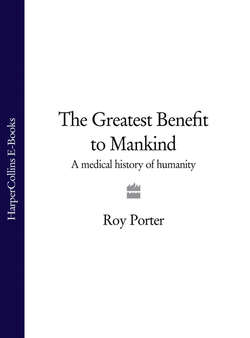Читать книгу The Greatest Benefit to Mankind: A Medical History of Humanity - Roy Porter - Страница 60
THE MIND
ОглавлениеRenaissance humanism, mysticism, hermeticism and astrology fostered interest in the human soul, the spiritual fulcrum in a cosmos governed by supernatural forces – good and evil. It is not surprising, therefore, that one field in which Renaissance philosophy made a contribution to medicine was mental disorder. Theories remained complex, however. The neo-Platonist Ficino related melancholia to the sway of Saturn, but also to the action of black bile, the humour of genius and of depression.
Humanist moralists explored the mind, notably the French essayist, Michel de Montaigne (1533–92), twice mayor of Bordeaux. Suffering agony from a bladder stone* and sickened by religious and dynastic bloodshed, he retired from the world to compose his mind in tranquillity, only to find himself haunted by ‘monsters’ and ‘chimeras’. Solitude sparked ‘melancholy adust’, a sick humour disposing his melancholic temperament towards madness. Composing his Essais (1580) was an antidote, a writing cure aimed at restoring balance through anatomizing his mind in quest of self-knowledge.
Montaigne kept his soul ‘at home’ in the body, studying both, hoping to grasp how man should live wisely and face death well. Yet in response to the old Socratic injunction of self-knowledge (‘nosce te ipsum’), he was sceptical: Que sçay-je? (What do I know?), he asked. Such themes were relentlessly pursued, not least by Shakespeare, whose contemporary, Robert Burton (1557–1640), described himself as ‘fatally driven’ upon the rock of melancholy and mixed philosophy and medicine. His Anatomy of Melancholy (1621) was a satirical flagellation of folly but also a serious medical inquiry which included the following causes of depression: ‘idleness, solitariness, overmuch study, passions, perturbations, discontents, cares, miseries, vehement desires, ambitions’, and hundreds more.
Philosophical medicine explored sickness of the mind and its synergy with the body. Mingling suspicion with sympathy, paintings and plays made much of fools, melancholies and madmen. ‘Bedlam’ acquired its notoriety, and Tom o’ Bedlam became a well-known figure, wandering the lanes, singing and begging. The period also brought the wave of mass hysteria and persecution known as the witch-craze. Despite the biblical injunction, ‘thou shalt not suffer a witch to live’ (Exodus 22:18), the medieval Church had long remained little concerned about witchcraft, but by the late fifteenth century this had changed, and a Papal Bull of 1484 condemned its spread and authorized a crackdown on its practitioners. Two years later, the Malleus maleficarum [Hammer of the Witches] of the Dominicans, Institoris and Sprenger, created a witchfinders’ handbook that passed through more than twenty editions and translations. Accusations spread, especially where religious conflict and social tension were rife, and trials and executions mounted till around 1650. As late as 1692 the Salem, Massachusetts, trials resulted in thirty executions, and witches were still occasionally being executed in parts of Europe on the eve of the French Revolution.
Nineteenth-century psychiatrists retrospectively diagnosed witches as mentally disturbed, their confessions of compacts with the Devil being the progeny of delusions and hysterical personalities. More recently, such charges have been levelled primarily at the witch-hunters, for whipping up mass hysteria. Though most early-modern doctors supported the prosecution of witches, a few were sceptical, and doubts were particularly expressed in the De praestigiis daemonum (1563) [On the Conjuring Tricks of Demons] of Johannes Weyer (1515 – 88). Weyer was the town medical officer of Arnhem in the Netherlands, and he warned against mistaking sickness for Satan. The Devil had no power over the body; so-called witches imagined the enormities they confessed, perhaps in the throes of fever. He insisted that the deeds of which they were accused – causing sudden death, impotence or crop failure – were natural occurrences. Witches were to be pitied and healed rather than harried and punished.
Felix Platter (1536–1614), dean of the medical faculty at the University of Basel, left extensive accounts of psychiatric disorders in his Praxis medica (1602) [The Practice of Medicine] and Observationum (1614) [Observations]. From a medical viewpoint he downplayed diabolical agency, though advising the use of amulets in cases of madness. He discussed hysteria and sexual disorders, described cretinism (then common in Switzerland), and advocated a basket of psychological, pharmacological and physical therapies. Occasionally at witch trials, medical and theological interpretations of insanity clashed. Yet it was not until the triumph of the mechanical philosophy that a naturalistic theory of mind gained ground, ruling out the supernatural element in mental illness.
A window is offered onto the deranged by the case notes of the Revd Richard Napier (1559–1634), a contemporary of Shakespeare’s who specialized in healing those afflicted in mind and spirit. A high proportion of the afflicted visiting him suffered family troubles, financial insecurities and religious torments, and many believed they were bewitched. Of the 134 cases of deep depression this Anglican clergyman handled, fifty-eight were attributed to deep grief following children’s deaths (‘Much grief for the death of two children’, one parent related). Of Agnys Morton, who had murdered her illegitimate baby, evidently suffering from puerperal fever, Napier recorded,
This woman is distracted of her wits … went to make herself away, being tempted as she sayeth thereunto by the Tempter. Will not in any case say her prayers … Very ravenous and greedy, and will say the foul Fiend lyeth at her heart, that she cannot feed him fast enough.
Napier cast horoscopes in forming his diagnoses, and healed with a mixture of herbal remedies, prayer and counsel, often giving patients sigils and talismans. He may be regarded as one of the last Renaissance magi.
